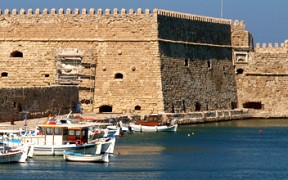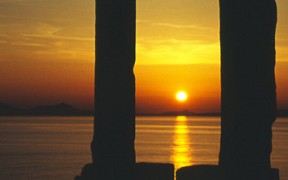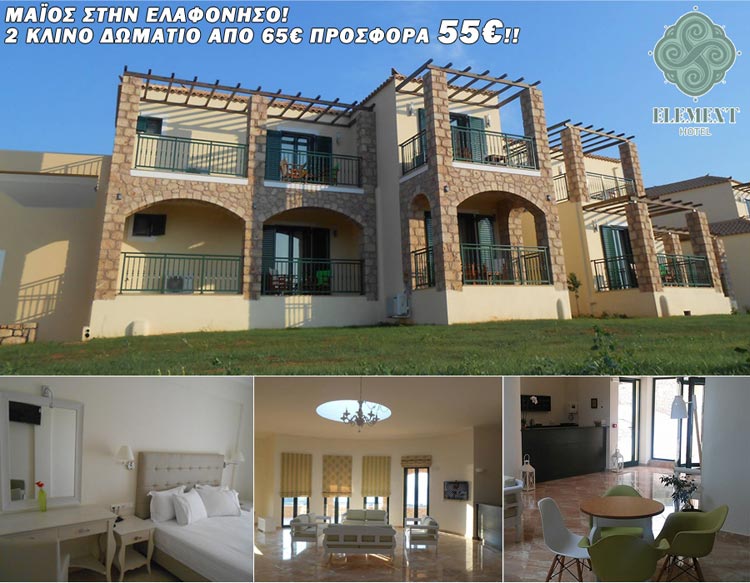Delphi Archaeological Museum
The Archaeological Museum of Delphi, one of the most important in Greece, exhibits the history of the Delphic sanctuary, site of the most famous ancient Greek oracle. Its rich collections are comprised primarily of architectural sculpture, statues and minor objects donated to the sanctuary. These reflect its religious, political and artistic activities from its early years in the eight century BC to its decline in Late Antiquity.
The museum is housed in a two-storey building with a total surface area of 2270 square metres, with fourteen exhibition rooms, 558 square metres of storerooms and conservation laboratories for pottery, metal objects and mosaics. A new lobby, cafeteria and gift shop were created during the museum's latest refurbishment.
The museum is overseen by the Tenth Ephorate of Prehistoric and Classical Antiquities.
History
The first Delphi Museum was built in 1903 on plans by the French architect Tournaire and funded by A. Syngros in order to house the finds of the great French excavations begun in 1892. The original building, which consisted of two wings, was enlarged and renovated in 1935-6. The new exhibition opened two years later and was organized like the first one by Greek and French archaeologists. A storeroom for inscriptions was constructed in 1956. The complete refurbishment of the museum in accordance with recent museological thinking, especially since many of the antiquities had been stored away during the Nazi occupation, was deemed necessary in 1958 and was carried out by the architect Patroklos Karantinos. Two new rooms, one for the Charioteer and the other for the bronze objects, were created, while the existing three were refurbished. Old storerooms were converted into offices and a guesthouse. A portico was built in front of the offices for the exhibition of Hellenistic statues, but was blocked in 1980 by new offices, while a new adjacent building containing more storerooms (for statues, vases and architectural elements) and laboratories, was added. The new exhibition was established between 1960 and 1963.
In 1975, part of the sculpture laboratory and storeroom was used for the exhibition of the bull and chryselephantine objects from the recently excavated votive deposit of the Sacred Way. The conversion was completed and the exhibition inaugurated in 1978. In 1979, a second staircase leading to the museum's entrance was created. The latest enlargement and renovation was completed in 1999. It included the refurbishment of the existing exhibition rooms, the modernization and creation of new laboratories, the construction of new storerooms and offices, and of a lobby, cafeteria and gift shop, the landscaping of the area surrounding the museum and the repair of the museum's architectural shell, roof and floor. All of the museum's collections were redisplayed to meet modern museological standards, new exhibits and contemporary information technology were added for visitors.
Exhibition Units
- Rooms Ι-ΙΙ
The emergence of the sanctuary and the early offerings
This unit presents the early years of the sanctuary, before the establishment of the cult of Apollo, and the transition to a new area and new cult. Mycenaean figurines and Minoan stone rhyta are displayed with bronze tripods, the earliest offerings to the new deity. Creto-Cypriot shields, a Phoenician bowl, Phrygian fibulae and Syrian sirens are among the early bronze offerings. A series of votive male figurines of the Geometric period completes the display in Room I. Room II contains the remaining bronze offerings of the eighth and seventh centuries BC: animal figurines, women's jewellery, votive helmets and the famous 'daedalic kouros', a small bronze precursor of the large-scale marble statues of the sixth century, presented in Room III. - Room ΙΙΙ
The early Archaic period
The twin kouroi, a selection of bronze objects of the same period and the tufa frieze of the Sikyonian Treasury are displayed in this unit. - Room IV
The Sacred Way votive pit
The finds from the votive pit of the Sacred Way are representative of the offerings dedicated by the Eastern Greek cities in the Archaic period. The display also includes the Apollonian Triad and a silver bull. - Room V
The Siphnian Treasury
This unit presents parts of the architectural sculpture (frieze, east pediment, door jambs and lintel, karyatides) of the Treasury of the Siphnians, the Naxian Sphinx and architectural sculpture from other buildings of the sanctuary. - Room VI
The Temple of Apollo
Architectural elements of the Temple of Apollo, including the pedimental statuary of the Archaic and Classical temples, comprise this unit. - Room VII-VIII
The Athenian Treasury
The sculptural decoration of the Treasury of the Athenians comprises this unit. Room VII contains the frieze and metopes, while the two preserved acroteria representing Amazons on horseback, parts of the pediments and the later inscriptions with the hymns to Apollo are presented in Room VIII. - Room IX
Offerings of the fifth century BC
This unit presents a selection of offerings of the fifth century BC, including the sculptural and terracotta painted decoration of the two treasuries of the sanctuary of Athena Pronaia (Treasury of Massalia and the Doric Treasury), acroteria from the other buildings of this sanctuary and characteristic waterspouts and antefixes from both sanctuaries. It also presents the three bronze statues found in the votive pit of the Sacred Way: a 'peplophoros' holding an incense burner, a man playing the flute and a group of two athletes. A female head from the sanctuary of Athena Pronaia completes the display and heralds the transition to the fourth century BC. - Room X
The Tholos
This room is dedicated to the Tholos, the circular building in the sanctuary of Athena Pronaia. The display consists of architectural elements and parts of the building's sculptural decoration, including two characteristic capitals, one Doric and one Corinthian, the metopes and the two friezes. - Room XI
Late Classical and Hellenistic periods
The offering of Daochos, the Omphalos and the column with the dancing girls dominate the display. A series of Late Classical and Hellenistic statues illustrate the wealth of the offerings donated to the sanctuary. - Room XII
Late Hellenistic and Roman periods
The frieze of the offering of Aemilius Paulus, the first in a series of Roman monuments of the sanctuary, dominates Room XII. Several Late Hellenistic and Roman works, such as the circular altar of the Pronaia, the statue of Antinoos, the alleged portrait of Titus Flamininus and representative examples of Roman metalwork complete the display. - Room XIII
The Charioteer
This room is dedicated to the Charioteer one of the most famous and most important exhibits of the museum. - Room XIV
The end of the sanctuary
This unit illustrates the last centuries of the sanctuary through inscriptions and portraits of Roman emperors, and architectural elements and lamps with Christian symbols, characteristic of the transition to the new religion.
Source: Ministry of Culture
Accommodation in Phocis (Fokida)
For your stay in Phocis, you can book a room in one of the hotels and Bed & Breakfast inns. In Amfissa as well as in ma...
Phocis (Fokida): Access, transportation, useful info and telephones
Access from the rest of Greece to different areas of the Prefecture of Phocis is quite easy. The geographical location o...
Location articles: Fokis - Fokida
Articles, tributes and reviews for the location with useful information and suggestions...























